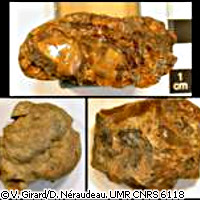ESRF gives researchers a closer look inside opaque amber
Palaeontologists are conscientious in their quest to understand the history of life on Earth. For them, an important source of fossil evidence has been amber, the oldest sample of which dates back to the carbon era, 345 million years. The European Synchrotron Radiation Facility (ESRF) has now given palaeontologists, who already use classical microscopy techniques, a new tool to study opaque amber: synchrotron X-rays. Using the synchrotron, scientists from the ESRF and the University of Rennes in France found 356 animal fossils in 2 kilograms of opaque amber originating from the mid-Cretaceous sites of France's Charentes region. These animal fossils are 100 million years old, and include flies, wasps and spiders. For the study, the group imaged 640 pieces of amber from the French region. Despite the fact that the majority of organisms discovered are tiny, the scientists identified families for 53% of the samples. 'The small size of the organisms in the amber would suggest that bigger animals were able to escape from the resin before becoming trapped,' explains Malvina Lak, a palaeontologist at the University of Rennes, and member of the research team. 'The smaller ones were captured more easily.' Opaque amber represents more than 75% of the amber found in sites from the Cretaceous period (from135 million to 63 million years ago), a time that saw the disappearance of dinosaurs and the emergence of modern insects and flowering plants. However, studying this kind of amber has proved difficult, since the presence of fossils cannot be determined with the naked eye. To find out what was inside the stone, Ms Lak and her colleagues and Dr Paul Tafforeau of the ESRF, along with researchers from the National Museum of Natural History of Paris, made use of the synchrotron X-ray imaging technique 'propagation phase contrast microradiography'. The technique permits light to reach the interior of this dark amber. 'Researchers have tried to study this kind of amber for many years with little or no success,' explains Dr Tafforeau. 'This is the first time that we can actually discover and study the fossils contained within.' The scientists used the same technique in a second study to reveal the 3D structure of feathers found in the translucent amber. It is important to study these fragments, the scientists believe, because little is known about feathered dinosaurs and the missing link with modern feathers. The study provides the first fossil evidence of an intermediate stage in the evolutionary diversification of feathers. 'Opaque amber hosts many still unknown aspects of the past life on our planet, and the use of third generation synchrotron sources will continue to play an important role in unveiling them,' says Ms Lak. The ESRF, which is located in Grenoble, France, is a joint facility backed and shared by 18 European countries. The facility is a magnet for thousands of researchers, including biologists, geophysicists and archaeologists, who seek to work in a first-class scientific environment.
Countries
France



